不涉及transformer原理,只看transform结构的具体运行过程,涉及到推理。关于原理细节可参考这篇或者查阅其他相关优秀文章。
一、Transformer 基本结构
Transformer由encoder和decoder组成,其中:
-
encoder主要负责理解(understanding) The encoder’s role is to generate a rich representation (embedding) of the input sequence, which the decoder can use if needed
-
decoder主要负责生成(generation) The decoder outputs tokens one by one, where the current output depends on the previous tokens. This process is called auto-regressive generation
基本结构如下:
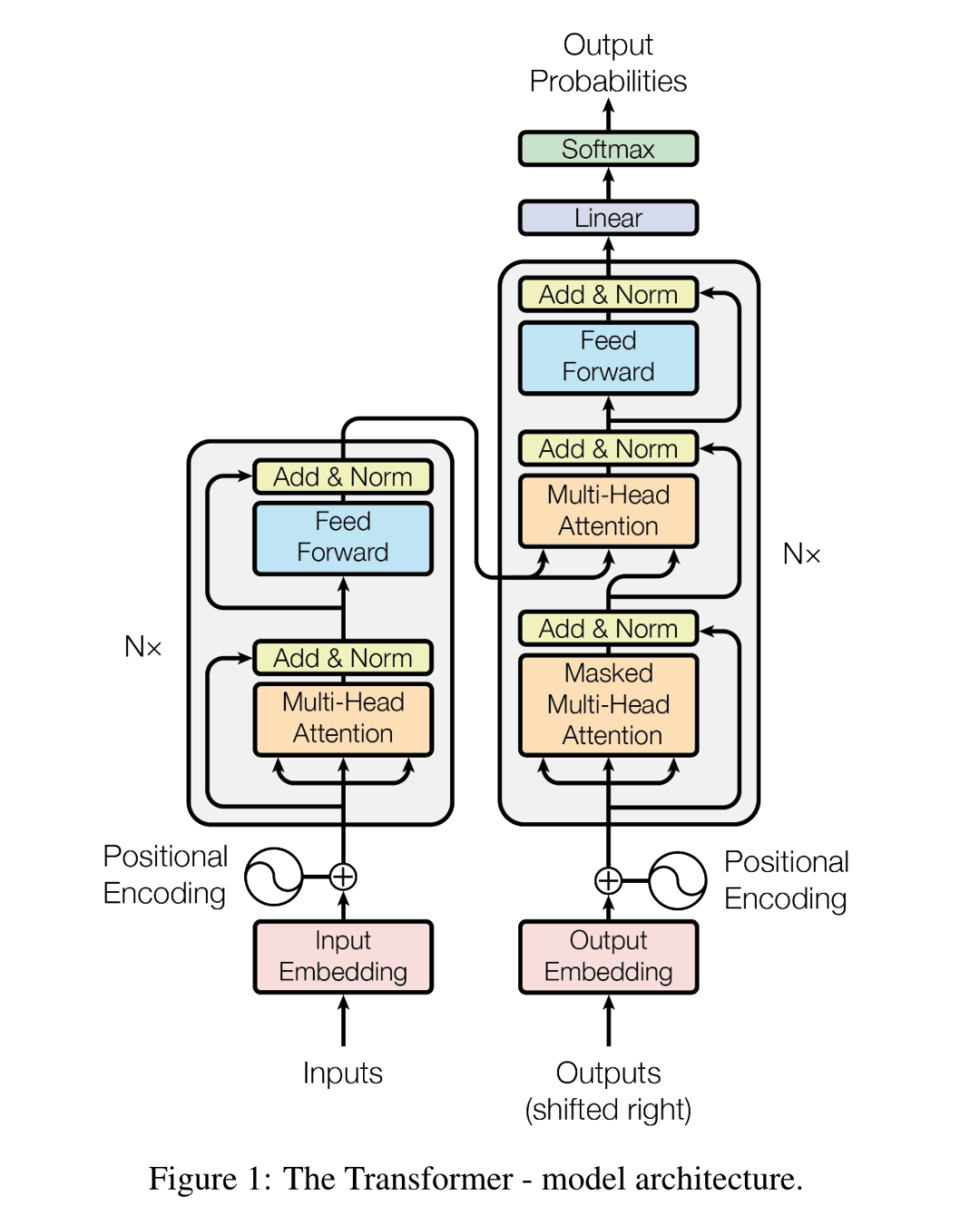
encoder结构和decoder结构基本一致(除了mask),所以主要看decoder即可:
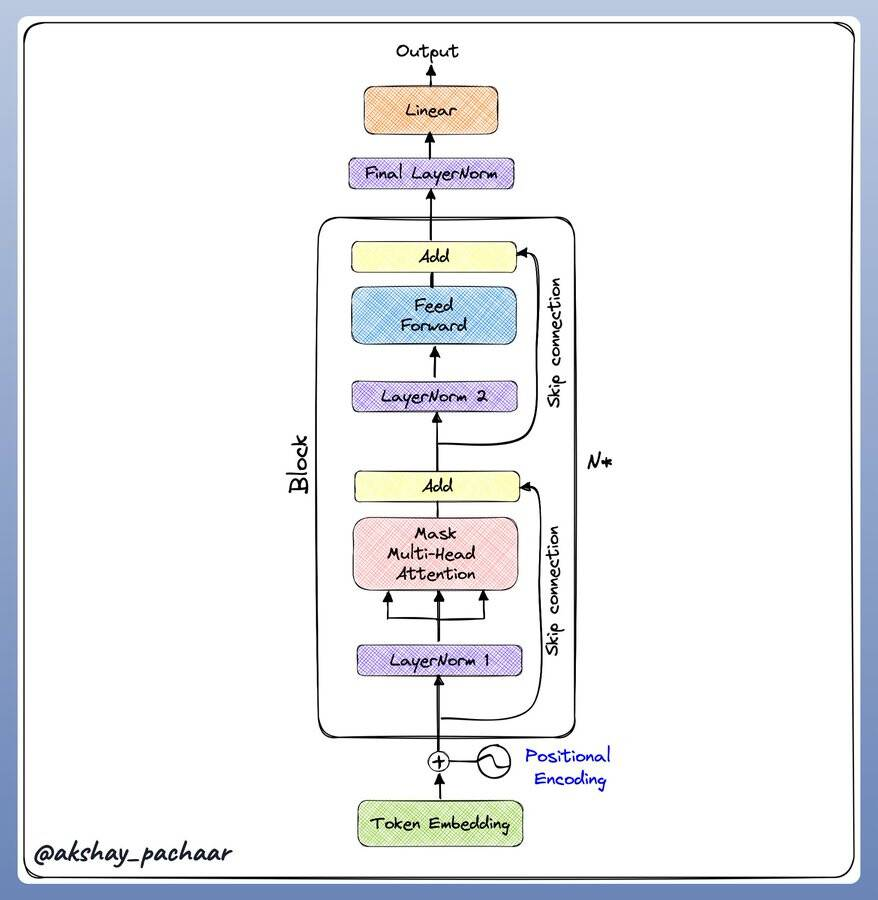
每个核心的Block包含:
- Layer Norm
- Multi headed attention
- A skip connection
- Second layer Norm
- Feed Forward network
- Another skip connection
看下llama decoder部分代码,摘自transformers/models/llama/modeling_llama.py,整个forward过程和上图过程一模一样, 只是layer_norm换成了LlamaRMSNorm:
# 省略了一些不重要的code
class LlamaDecoderLayer(nn.Module):
def __init__(self, config: LlamaConfig, layer_idx: int):
...
def forward(
self,
hidden_states: torch.Tensor,
attention_mask: Optional[torch.Tensor] = None,
position_ids: Optional[torch.LongTensor] = None,
past_key_value: Optional[Tuple[torch.Tensor]] = None,
output_attentions: Optional[bool] = False,
use_cache: Optional[bool] = False,
cache_position: Optional[torch.LongTensor] = None,
**kwargs,
) -> Tuple[torch.FloatTensor, Optional[Tuple[torch.FloatTensor, torch.FloatTensor]]]:
# hidden_states [bsz, q_len, hidden_size]
residual = hidden_states
hidden_states = self.input_layernorm(hidden_states)
# Self Attention 即MHA
hidden_states, self_attn_weights, present_key_value = self.self_attn(
hidden_states=hidden_states,
attention_mask=attention_mask,
position_ids=position_ids,
past_key_value=past_key_value,
output_attentions=output_attentions,
use_cache=use_cache,
cache_position=cache_position,
**kwargs,
)
hidden_states = residual + hidden_states
# Fully Connecte
residual = hidden_states
hidden_states = self.post_attention_layernorm(hidden_states)
hidden_states = self.mlp(hidden_states)
hidden_states = residual + hidden_states
outputs = (hidden_states,)
return outputs
上述代码展示的是标准的decoder过程,几个关键输入:
-
hidden_states [batch_size, seq_len, embed_dim] seq_len表示输入长度
-
attention mask的size为
(batch_size, 1, query_sequence_length, key_sequence_length)注意力掩码,实际使用的时候,PyTorch 会自动广播这个掩码到注意力权重矩阵的形状 [bsz, num_heads, q_len, kv_seq_len]。 -
position_ids or position_embeddings,位置id或者已经提前计算好的位置embedding
上述最核心的结构是其调用的self.self_attn,即是Multi-headed attention。
二、Multihead Attention
Multihead Attention,多头注意力,上述decoder过程中最核心的地方,同时也是算子优化发力的地方。要理解多头先从单头开始。
单个attention
即Scaled Dot-Product Attention,公式如下:

其中QKV的维度一致,比如这里都是(2,3):
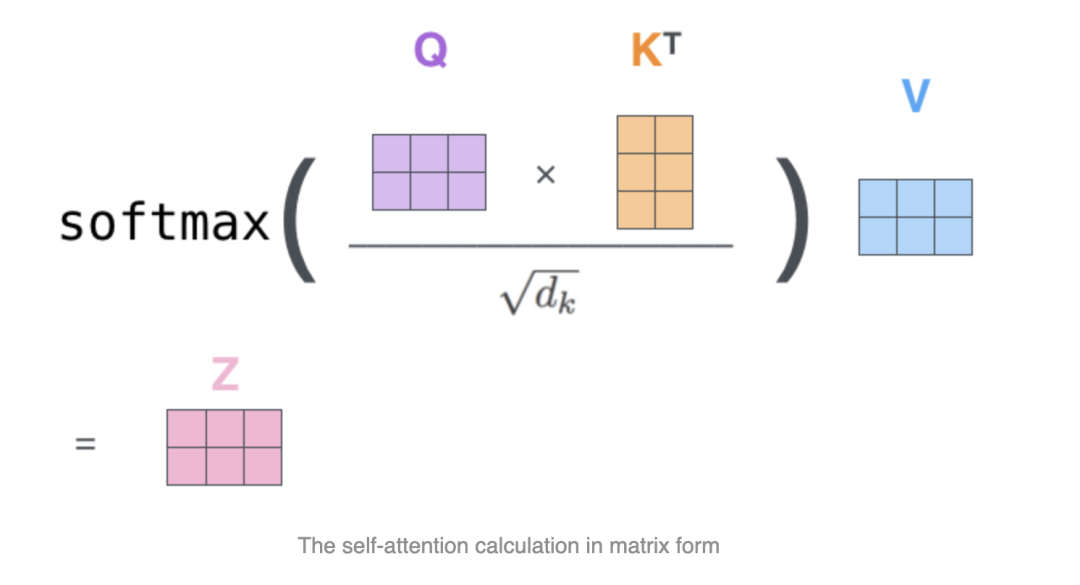
那么QKV怎么得到的呢?通过输入embedding和WqWkWv相乘得到qkv,这里WqWkWv是可学习参数:

拆开合起来计算都是等价的,上述的X1和X2是拆开计算,但是组合起来为(2,4)维度,同样可以和WqWkWv进行矩阵乘
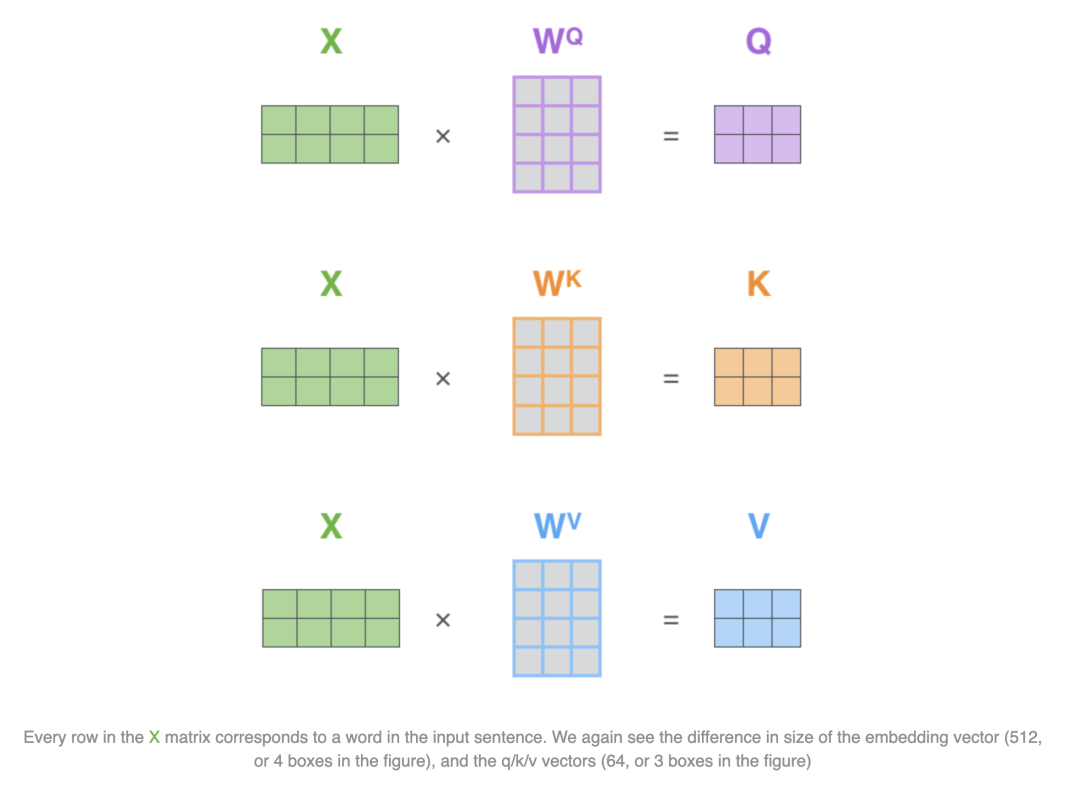
实际在decoder的计算中,会带入causal (or look-ahead) mask:
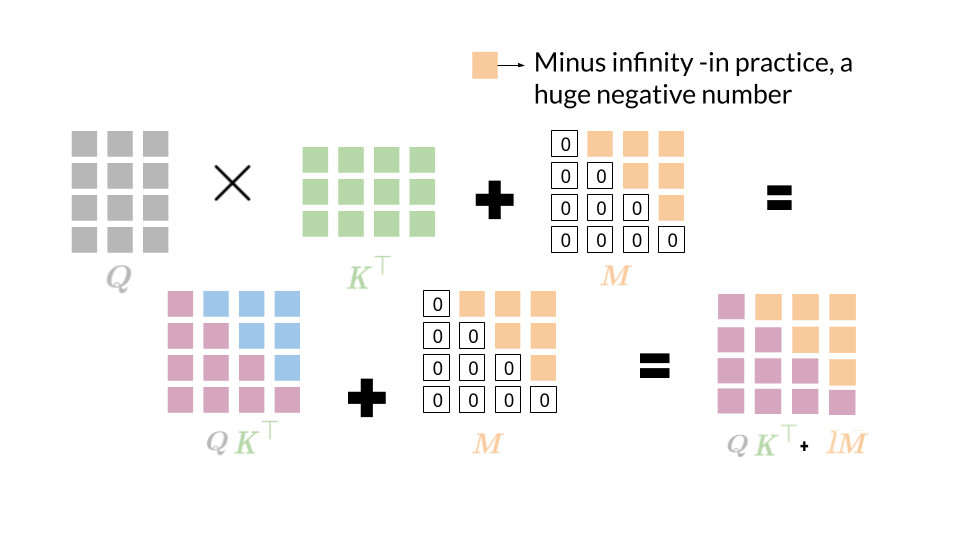
Causal mask 是为了确保模型在解码时不会关注未来的 token,这对于生成任务是必不可少的。通过这个掩码,模型只会依赖已经生成的 token,确保解码过程中是自回归的。
多个attention
实际中一般都是多个attention,和单个attention区别不大,下图右侧是多个attention的结构:
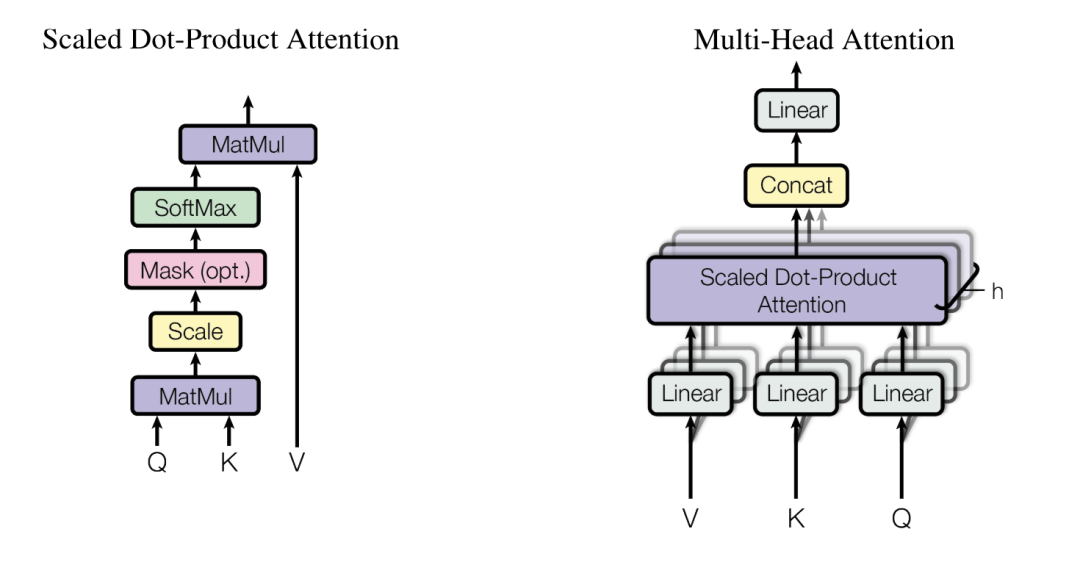
自注意力在多个头部之间并行应用,最后将结果连接在一起,我们输入(2,4)维度的X,分别和不同头的WqWkWv进行矩阵乘法得到每个头对应的QKV,然后QKV算出Z,再将所有Z合并和Wo相乘得到维度和X一致的Z:
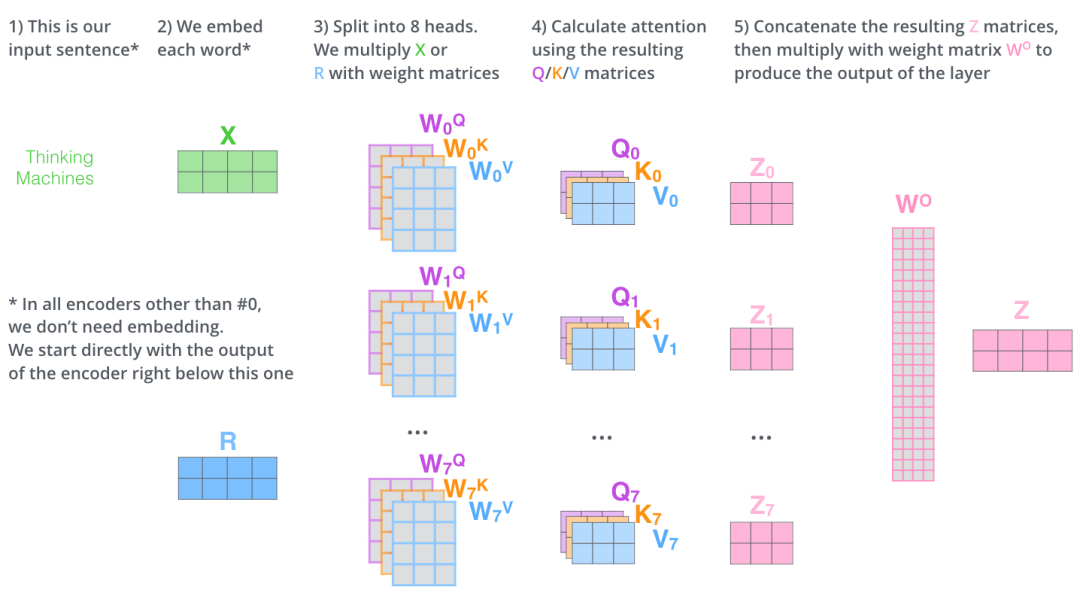
实际中需要学习的权重为每个头的WqWkWv,同时也需要一个Wo,看一下llama中的实际计算过程:
class LlamaAttention(nn.Module):
"""Multi-headed attention from 'Attention Is All You Need' paper"""
def __init__(self, config: LlamaConfig, layer_idx: Optional[int] = None):
super().__init__()
self.config = config
self.layer_idx = layer_idx
self.attention_dropout = config.attention_dropout
self.hidden_size = config.hidden_size
self.num_heads = config.num_attention_heads
self.head_dim = self.hidden_size // self.num_heads
self.num_key_value_heads = config.num_key_value_heads
self.num_key_value_groups = self.num_heads // self.num_key_value_heads
self.max_position_embeddings = config.max_position_embeddings
self.rope_theta = config.rope_theta
self.is_causal = True
# 这行代码是一个检查条件,确保hidden_size能够被num_heads整除。
# 在多头注意力(Multi-Head Attention, MHA)机制中,输入的hidden_size被分割成多个头,每个头处理输入的一个子集。
# head_dim是每个头处理的维度大小,它由hidden_size除以num_heads得到。
if (self.head_dim * self.num_heads) != self.hidden_size:
raise ValueError(
f"hidden_size must be divisible by num_heads (got `hidden_size`: {self.hidden_size}"
f" and `num_heads`: {self.num_heads})."
)
# 需要学习更新的四个权重 WqWkWvWo
self.q_proj = nn.Linear(self.hidden_size, self.num_heads * self.head_dim, bias=config.attention_bias)
self.k_proj = nn.Linear(self.hidden_size, self.num_key_value_heads * self.head_dim, bias=config.attention_bias)
self.v_proj = nn.Linear(self.hidden_size, self.num_key_value_heads * self.head_dim, bias=config.attention_bias)
self.o_proj = nn.Linear(self.num_heads * self.head_dim, self.hidden_size, bias=config.attention_bias)
self._init_rope()
def forward(
self,
hidden_states: torch.Tensor,
attention_mask: Optional[torch.Tensor] = None,
position_ids: Optional[torch.LongTensor] = None,
past_key_value: Optional[Cache] = None,
output_attentions: bool = False,
use_cache: bool = False,
**kwargs,
) -> Tuple[torch.Tensor, Optional[torch.Tensor], Optional[Tuple[torch.Tensor]]]:
bsz, q_len, _ = hidden_states.size()
query_states = self.q_proj(hidden_states)
key_states = self.k_proj(hidden_states)
value_states = self.v_proj(hidden_states)
query_states = query_states.view(bsz, q_len, self.num_heads, self.head_dim).transpose(1, 2)
key_states = key_states.view(bsz, q_len, self.num_key_value_heads, self.head_dim).transpose(1, 2)
value_states = value_states.view(bsz, q_len, self.num_key_value_heads, self.head_dim).transpose(1, 2)
kv_seq_len = key_states.shape[-2]
if past_key_value is not None:
if self.layer_idx is None:
raise ValueError(
f"The cache structure has changed since version v4.36. If you are using {self.__class__.__name__} "
"for auto-regressive decoding with k/v caching, please make sure to initialize the attention class "
"with a layer index."
)
kv_seq_len += past_key_value.get_usable_length(kv_seq_len, self.layer_idx)
cos, sin = self.rotary_emb(value_states, seq_len=kv_seq_len)
query_states, key_states = apply_rotary_pos_emb(query_states, key_states, cos, sin, position_ids)
if past_key_value is not None:
cache_kwargs = {"sin": sin, "cos": cos} # Specific to RoPE models
key_states, value_states = past_key_value.update(key_states, value_states, self.layer_idx, cache_kwargs)
key_states = repeat_kv(key_states, self.num_key_value_groups)
value_states = repeat_kv(value_states, self.num_key_value_groups)
attn_weights = torch.matmul(query_states, key_states.transpose(2, 3)) / math.sqrt(self.head_dim)
if attention_mask is not None:
if attention_mask.size() != (bsz, 1, q_len, kv_seq_len):
raise ValueError(
f"Attention mask should be of size {(bsz, 1, q_len, kv_seq_len)}, but is {attention_mask.size()}"
)
attn_weights = attn_weights + attention_mask
# upcast attention to fp32
attn_weights = nn.functional.softmax(attn_weights, dim=-1, dtype=torch.float32).to(query_states.dtype)
attn_weights = nn.functional.dropout(attn_weights, p=self.attention_dropout, training=self.training)
# (bsz, self.num_heads, q_len, self.head_dim)
attn_output = torch.matmul(attn_weights, value_states)
# (bsz, q_len, self.num_heads, self.head_dim)
attn_output = attn_output.transpose(1, 2).contiguous()
attn_output = attn_output.reshape(bsz, q_len, self.hidden_size)
attn_output = self.o_proj(attn_output)
return attn_output, attn_weights, past_key_value
上述的计算过程可以总结为以下几个步骤,假设输入张量hidden_states的维度为[batch_size, seq_length, hidden_size]。


这个过程实现了将输入通过多个注意力"头"并行处理的能力,每个"头"关注输入的不同部分,最终的输出是所有"头"输出的拼接,再经过一个线性变换。这种机制增强了模型的表达能力,使其能够从多个子空间同时捕获信息。
因为不用GQA,q_len 就是 seq_length 就是 kv_seq_len
三、MHA计算
实际的多头计算代码如下,这里是通过torch.matmul实现的:
attn_weights = torch.matmul(query_states, key_states.transpose(2, 3)) / math.sqrt(self.head_dim)
if attention_mask is not None: # no matter the length, we just slice it
causal_mask = attention_mask[:, :, :, : key_states.shape[-2]]
attn_weights = attn_weights + causal_mask
position_ids: Optional[torch.LongTensor] = None,
# upcast attention to fp32
attn_weights = nn.functional.softmax(attn_weights, dim=-1, dtype=torch.float32).to(query_states.dtype)
attn_weights = nn.functional.dropout(attn_weights, p=self.attention_dropout, training=self.training)
attn_output = torch.matmul(attn_weights, value_states)
上述代码中query_states和key_states的形状分别为[bsz, num_heads, q_len, head_dim]和[bsz, num_heads, kv_seq_len, head_dim]。matmul操作会自动在最后两个维度上进行矩阵乘法,并在前两个维度上进行广播。
应用注意力掩码attn_weights = attn_weights + causal_mask,causal_mask的形状可能是[1, 1, q_len, kv_seq_len]。PyTorch会自动将其广播到attn_weights的形状[bsz, num_heads, q_len, kv_seq_len]。
应用softmax和dropout,然后最后计算attn_output = torch.matmul(attn_weights, value_states),其中attn_weights的形状为[bsz, num_heads, q_len, kv_seq_len],value_states的形状为[bsz, num_heads, kv_seq_len, head_dim]。matmul操作会在最后两个维度上进行矩阵乘法,并在前两个维度上进行广播。这里attn_output的维度为bsz, num_heads, q_len, self.head_dim。
四、torch.matmul
多维矩阵乘法,支持多维和broadcast,比较复杂:
- 如果两个输入张量都是一维张量,执行的是点积操作,返回一个标量
- 如果两个输入张量都是二维张量,执行的是矩阵乘法,返回一个新的二维矩阵,这个操作就是常见的
- 如果第一个张量是一维张量,第二个张量是二维张量,则会在第一张量的维度前面添加一个1(扩展为2维),然后进行矩阵乘法,计算完后会移除添加的维度
- 如果第一个张量是二维张量,第二个张量是一维张量,则执行的是矩阵-向量乘法,返回一个一维张量
- 当两个输入张量中有一个是多维的(N > 2),会执行批量矩阵乘法。在这种情况下,非矩阵的维度(批量维度)会被广播(broadcasted)。如果一个张量是一维,会对其进行维度扩展和移除
我们这里的多维数据 matmul() 乘法,可以认为该乘法使用使用两个参数的后两个维度来计算,其他的维度都可以认为是batch维度。
比如,输入张量的形状为 (j×1×n×n) 和 (k×n×n) 时,会输出形状为 (j×k×n×n) 的张量。
具体点,假设两个输入的维度分别是input (1000×500×99×11), other (500×11×99)那么我们可以认为torch.matmul(input, other, out=None) 乘法首先是进行后两位矩阵乘法得到(99×11)×(11×99)⇒(99×99) ,然后分析两个参数的batch size分别是 (1000×500)和 500, 可以广播成为 (1000×500), 因此最终输出的维度是(1000×500×99×99)。
计算QK点积的时候:
attn_weights = torch.matmul(query_states, key_states.transpose(2, 3)) / math.sqrt(self.head_dim)
query_states的形状为[bsz, num_heads, q_len, head_dim],key_states.transpose(2, 3)的形状为[bsz, num_heads, head_dim, kv_seq_len]。matmul操作会在最后两个维度上进行矩阵乘法,得到形状为[bsz, num_heads, q_len, kv_seq_len]的注意力权重。
计算注意力输出:
attn_output = torch.matmul(attn_weights, value_states)
这里使用torch.matmul将注意力权重与值(value)相乘。attn_weights的形状为[bsz, num_heads, q_len, kv_seq_len],value_states的形状为[bsz, num_heads, kv_seq_len, head_dim]。matmul操作会在最后两个维度上进行矩阵乘法,得到形状为[bsz, num_heads, q_len, head_dim]的注意力输出。
因为我们不用GQA,q_len 就是 kv_seq_len
最后分享
AI大模型作为人工智能领域的重要技术突破,正成为推动各行各业创新和转型的关键力量。抓住AI大模型的风口,掌握AI大模型的知识和技能将变得越来越重要。
学习AI大模型是一个系统的过程,需要从基础开始,逐步深入到更高级的技术。
这里给大家精心整理了一份全面的AI大模型学习资源,包括:AI大模型全套学习路线图(从入门到实战)、精品AI大模型学习书籍手册、视频教程、实战学习、面试题等,资料免费分享!

1. 成长路线图&学习规划
要学习一门新的技术,作为新手一定要先学习成长路线图,方向不对,努力白费。
这里,我们为新手和想要进一步提升的专业人士准备了一份详细的学习成长路线图和规划。可以说是最科学最系统的学习成长路线。

2. 大模型经典PDF书籍
书籍和学习文档资料是学习大模型过程中必不可少的,我们精选了一系列深入探讨大模型技术的书籍和学习文档,它们由领域内的顶尖专家撰写,内容全面、深入、详尽,为你学习大模型提供坚实的理论基础。(书籍含电子版PDF)

3. 大模型视频教程
对于很多自学或者没有基础的同学来说,书籍这些纯文字类的学习教材会觉得比较晦涩难以理解,因此,我们提供了丰富的大模型视频教程,以动态、形象的方式展示技术概念,帮助你更快、更轻松地掌握核心知识。

4. 大模型项目实战
学以致用 ,当你的理论知识积累到一定程度,就需要通过项目实战,在实际操作中检验和巩固你所学到的知识,同时为你找工作和职业发展打下坚实的基础。

5. 大模型面试题
面试,不仅是技术的较量,更需要充分的准备。在你已经掌握了大模型技术之后,就需要开始准备面试,我们将提供精心整理的大模型面试题库,涵盖当前面试中可能遇到的各种技术问题,让你在面试中游刃有余。

全套的AI大模型学习资源已经整理打包,有需要的小伙伴可以微信扫描下方CSDN官方认证二维码,免费领取【保证100%免费】

如有侵权,请联系删除。





















 1897
1897

 被折叠的 条评论
为什么被折叠?
被折叠的 条评论
为什么被折叠?








